Japanese Masks – The History of Traditional Japanese Masks
Japanese culture demonstrates many unique visual languages that are not only married to the nation and its heritage, but have also inspired many artists since the 20th century to explore the incredible and diverse aspects of Japanese culture that many can appreciate. From traditional Japanese fox masks to kabuki masks and Japanese cat masks, we will introduce you to one of the country’s most cherished art forms, masks, as well as a history of traditional Japanese masks, the different types of masks, and their uses in the past and Contemporary era. Keep reading for more about the enigmatic power of traditional Japanese masks!
Contents
- 1 The Tradition and History of Japanese Mask
- 2 Exploring the Different Types of Japanese Masks
- 2.1 Noh Masks
- 2.2 Kabuki Masks
- 2.3 Hannya Masks
- 2.4 Men-Yoroi Masks
- 2.5 Oni Masks
- 2.6 Tengu Masks
- 2.7 Kitsune Masks
- 2.8 Hyottoko Masks
- 2.9 Otafuku Masks
- 2.10 Shakkyo Masks
- 2.11 Kendo Masks
- 2.12 Tōkaidō Masks
- 2.13 Okame Masks
- 2.14 Somen Masks
- 2.15 Rokushaku Masks
- 2.16 Jō Masks
- 2.17 Menpo Masks
- 2.18 Gigaku Masks
- 2.19 Kappa Masks
- 2.20 Kyogen Masks
- 3 The Making of the Mask
- 4 Japanese Masks in the Contemporary Era
- 5 Frequently Asked Questions
The Tradition and History of Japanese Mask
What are Japanese masks? And when did they originate? The history of traditional Japanese masks has been dated back to the 14th century and were seen as an essential object of Japanese culture. The early wooden masks were first used in Noh theater performances, which were musical dramas invented during the Muromachi era in Japan. It is believed that the masks were first used by a famous actor named Zeami Motokiyo and had since progressed over time and through other specialized artists, into a variety of traditional mask types.
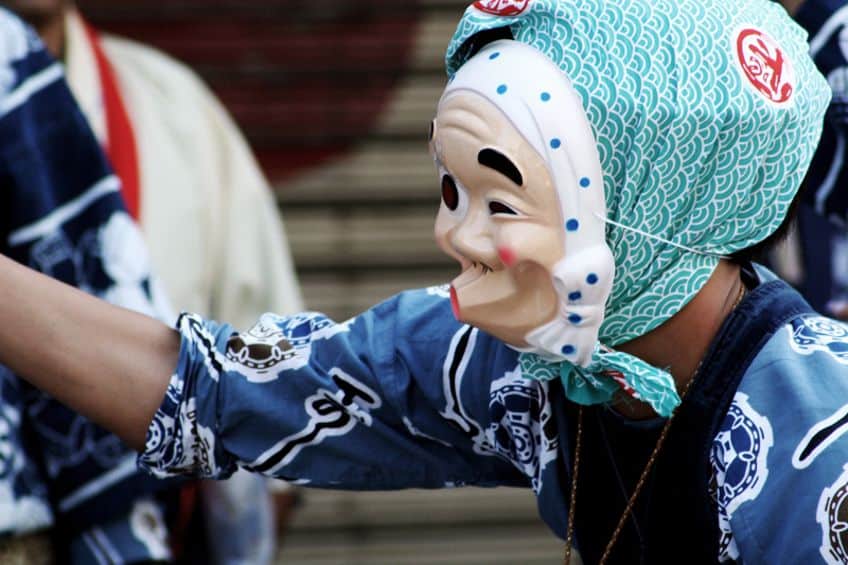
Noh theater performances were primarily organized and acted out by men who would wear masks that resembled women. Masks worn in Noh performances were crafted by highly skilled artisans and were used to convey a variety of emotions about a character. Traditionally, Japanese masks are carved from blocks of cypress wood and decorated with natural pigments. Over time, Noh masks evolved in style and design with some of the most popular mask-making families establishing themselves in the market as the Omote and the Hideta families, who specialized in the art of mask-making for generations. Beyond the Noh theater, Japanese masks also hold a significant cultural meaning since they are also used in Japanese religious ceremonies, cultural events, and festivals. Masks are also believed to hold important protective functions and carry spiritual qualities.
Below, we will dive into the different types of Japanese masks and outline their different meanings.
Exploring the Different Types of Japanese Masks
There are different types of traditional Japanese masks, each with its own origin story and function that offer insight into the rich cultural practices of traditional Japanese societies. Japanese culture is tied to the art of mask making, spanning art, religion, and entertainment. The practice of mask-making is considered to be a valuable and notable art practice that upholds the ancient visual cultures of the past and preserves its history for future generations. From the famous Hannya and Kitsune masks to the Noh and the Kyogen masks, we will now explore the many variations of the mask as found within traditional Japanese history.
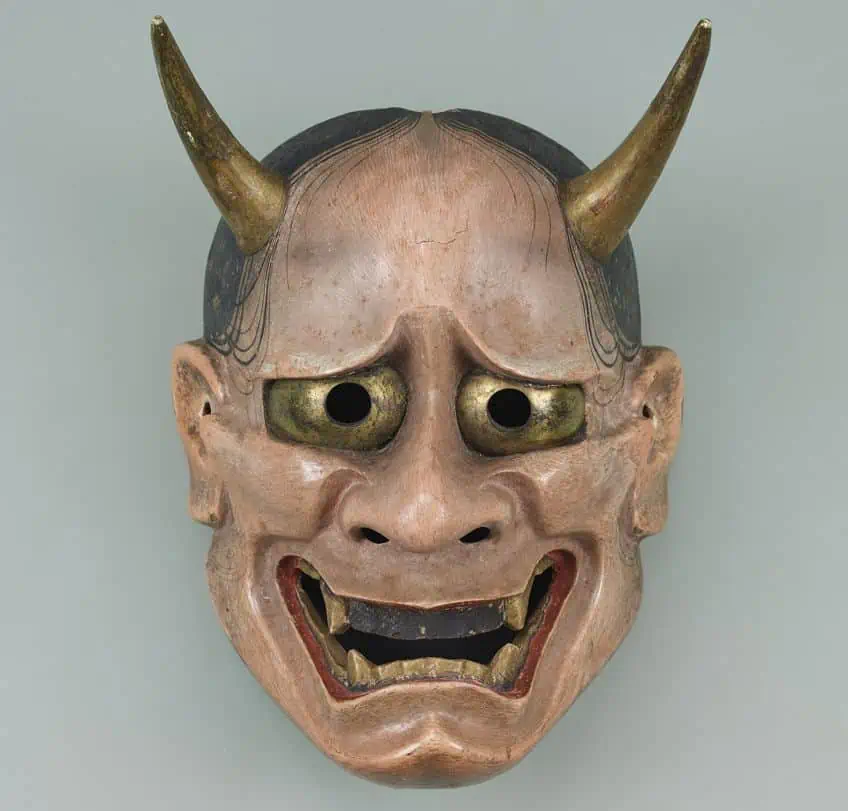
Noh Masks
What are Noh masks? Noh masks are one of the most well-known Japanese masks associated with Noh theater performances and generally refer to masks that were first used in religious rituals in the 14th century. The Noh masks evolved to dominate in Noh theater and were created using wood and clay. Noh masks were often painted in muted color palettes and decorated with detailed designs to reflect the character. Noh masks are also said to carry a spiritual meaning aside from forming an integral part of the theater performance and are also associated with the characters of certain Gods, mythical figures, women, and warriors. Whether the character appears ghastly or gorgeous, the main aim of the mask is to evoke an emotional response in the viewer.
Today, Noh masks are seen as important artifacts of Japan’s heritage whose craftsmanship has been passed down through generations to ensure the preservation of the art form through over 250 variations!
Kabuki Masks
Kabuki masks are another type of traditional Japanese mask that originated in the 17th century around the Edo period. These types of masks were popular until the 19th century and were essential elements of Kabuki theater performances. Similar to Noh masks, Kabuki masks help the audience identify the character in the play and are typically crafted out of paper Mache or wood. Kabuki theater was a popular form of theater where actors transformed their appearances using intricately designed masks and outfits to play multiple roles. Kabuki masks were created in a variety of shapes, colors, and sizes, which offered actors much practicality and diversity. Kabuki masks were vibrant and portrayed the characters of demons, Gods, and animals. These types of masks are also adopted in Japanese home décor with many enthusiasts collecting these masks for their cultural significance.
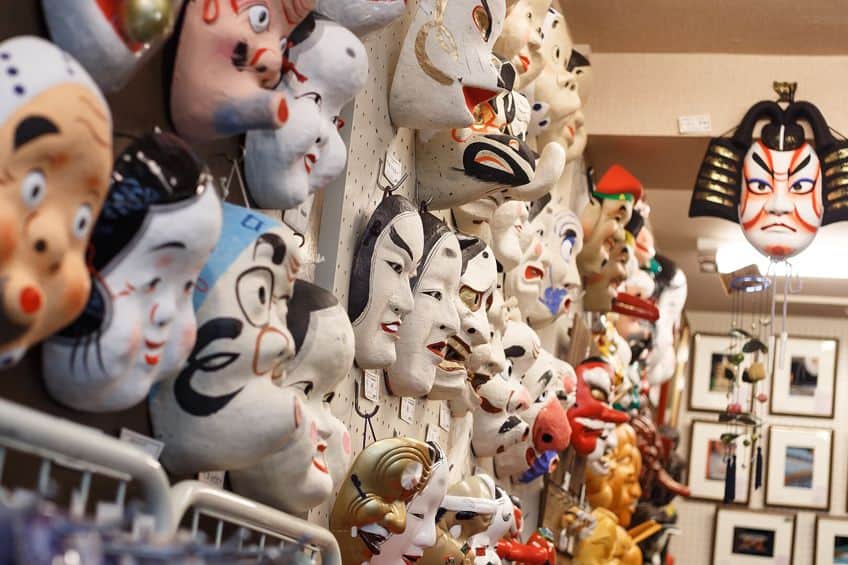
Hannya Masks
Hannya masks are another form of traditional Japanese mask that primarily represents a serpent with horns and fangs or a female demon. The Hannya mask is one of the oldest and most well-known types of Japanese masks that featured in Kyogen and Noh theater productions. The mask design is said to have originated from Buddhist influences and mythologies where the demon was a woman who had been consumed by rage and jealousy. Hannya masks debuted in Noh theater in the 14th century and later gained popularity in the 17th century as part of Kabuki theater. Kabuki theater productions tend to represent the Hannya mask as a vengeful spirit that seeks revenge against those who have wronged her. The mask is visually characterized by colors such as red, black, blue, and gold pairings and carved from wood to showcase a pronounced brow, twisted mouth, and sharp long teeth.
The appearance of the Hannya mask may seem evil, yet it is still a unique and powerful symbol of traditional Japanese cultural heritage.
Men-Yoroi Masks
Worn strictly by warriors and samurais, Men-yoroi masks were a customizable type of Japanese mask that was crafted according to the individual’s face. While Menpo masks cover a portion of the wearer’s face and Somon masks cover the entire face, Men-yoroi masks offer protection, comfort, anonymity, and intimidation.
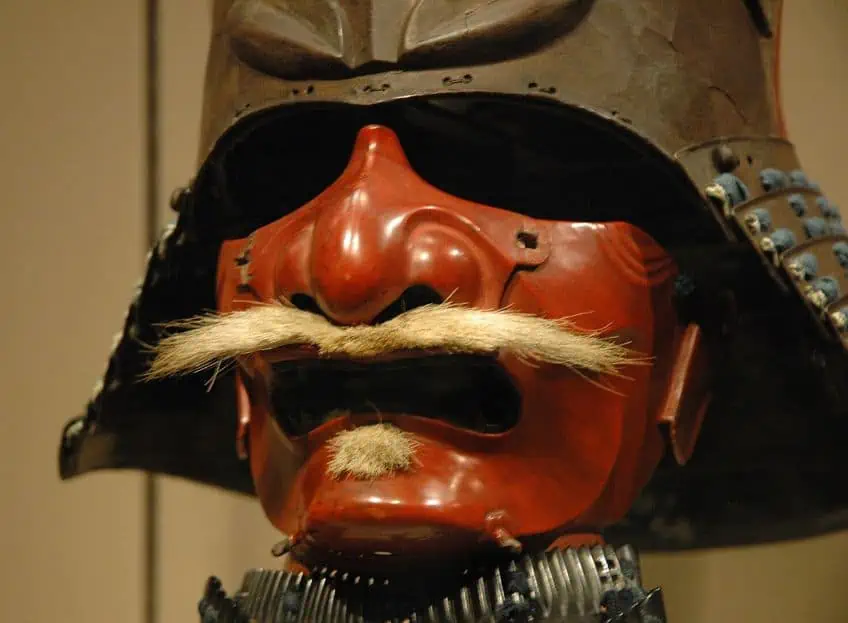
Oni Masks
The Japanese Oni mask displays a unique look and feel that is intimidating yet expressive and masterful in its depiction of mythological creatures. Oni masks are commonly associated with masks that represent ogres or demons and display a distinct look and feel. The Oni mask is characterized by its menacing expression bearing sharp fangs and horns. Oni masks are an important element of Japanese folklore and have evolved to symbolize power, protection, and strength. The origins of the mask were inspired by ancient Japanese mythology, where “Oni” were supernatural beings who enacted justice and punishment on those who behaved immorally and committed crimes. These types of masks were also traditionally decorated in bright pigments and worn during ceremonies to ward off evil spirits and invite good fortune. You may also recognize Japanese Oni masks from anime as well as the Setsubun festival, which is usually hosted on the last day of winter in line with the Japanese calendar.
The Setsubun festival is also identified as the bean-throwing festival where people chant prayers to ward off evil and throw beans. Dancers of the Setsubun festival wear Japanese Oni masks as well as those who prefer to stay indoors and celebrate at home with their families.
Tengu Masks
Tengu masks were inspired by an ancient Japanese mythological creature called a Tengu, which was a forest demon or spirit that linked the Tengu mask meaning to all things mischievous. The Tengu displayed features that were likened to a bird and human and were often depicted as a mischievous character and trickster who could either bring good luck or terrible misfortune. Tengu was part of popular folklore that circulated in the 14th century and was first introduced in the Noh theater. Similar to other 14th-century masks, Tengu masks were crafted from wood or papier Mache and then painted with exaggerated features in bright colors. The main features of the Tengu masks also focused on highlighting the creature’s bird-like features and contained horns, feathers, sharp teeth, and long noses. From a cultural perspective, the Tengu mask’s meaning is tied to its purpose as a protective talisman that was sometimes used in martial arts practices to help students develop their sense of concentration.
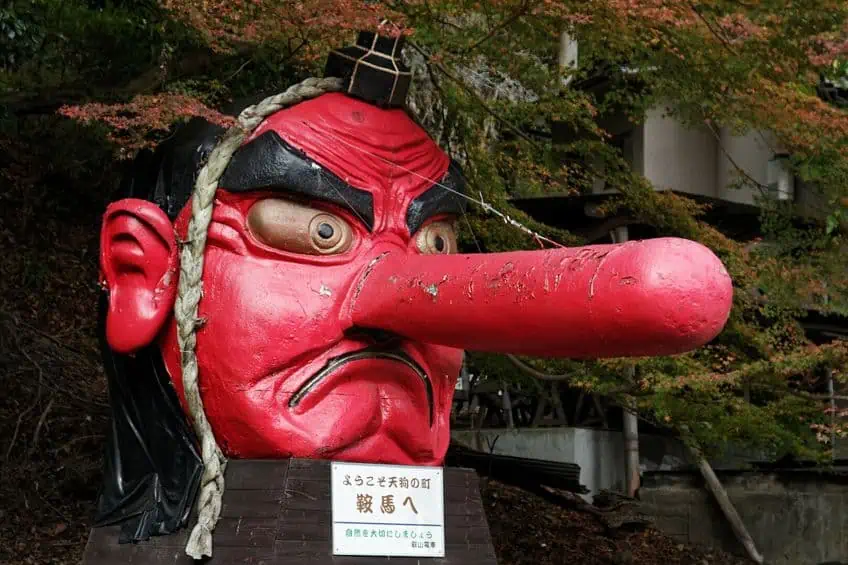
Kitsune Masks
What is a Kitsune mask? And what is the original Kitsune mask meaning? Commonly known as the Japanese cat mask, the Kitsune mask is among the most famous traditional Japanese masks that portray the fox or cat character. Foxes are often characters in Japanese mythology with the word “kitsune” translating directly to fox. A popular Kitsune mask meaning is linked to the belief that foxes possessed magical powers and were messengers of the Japanese God Inari. Foxes are also traditionally mischievous animals who play tricks on humans and manifest as fox spirit characters in theater performances. Japanese cat masks are created to resemble the visual elements of a fox and are normally created using wood with markings in red and white. The design is meant to resemble the face of a fox with a snout and pointed ears. Additionally, some artists added fur using horsehair for more detail.
The Japanese fox masks are also popular among ceremonies and tourists with fans and collectors of Japanese culture and artifacts acquiring these masks as souvenirs and accessories for cosplay.
Hyottoko Masks
Hyottoko masks are often presented in traditional Japanese theater alongside Otafuku masks to illustrate the harmony and balance in a relationship between a man and a woman. Hyottoko masks embody the character of a young man who appears to blow air from his mouth. The word “hyottoko” also translates to “fireman” and is a comedic symbol to illustrate a man who uses silly antics to “start a fire”, usually in a lighthearted and playful way.
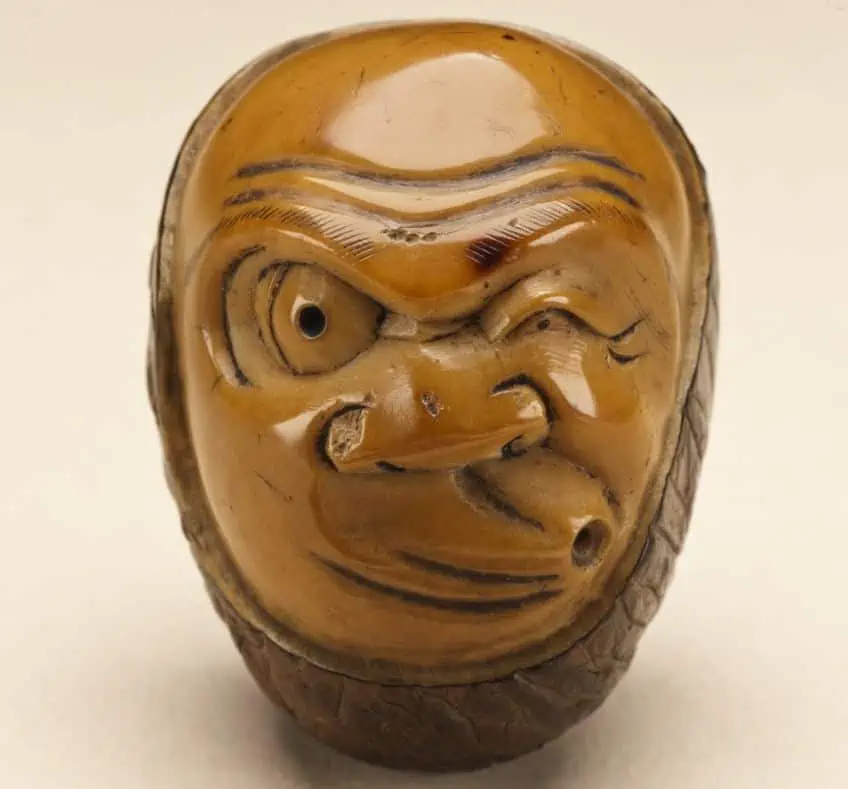
Otafuku Masks
Otafuku masks are also identified as Okame masks and are masks that represent a happy female. These traditional Japanese masks are used in Buddhist and Shinto rituals as well as Japanese theater performances and originated in the 14th century alongside Noh theater. Otafuku masks were used to represent female characters and progressed in association with Japanese folklore with the spirit of Okame used to represent a benevolent woman. These masks were also used in comedic roles where the performance would pair the character with another mask known as the Hyottoko mask, which was the male counterpart. The Otafuku masks were produced using lightweight woods such as paulownia wood and other light materials like papier-mache, and decorated in gold, white, and red. The facial expression represented on the masks featured wide eyes and rosy cheeks to evoke a sense of cheer.
The pairing of the Otafuku and the Hyottoko masks was intended to symbolize the harmony of the man and the woman in the play and has been adapted in Modern times in popular culture, manga, home décor, and anime.
Shakkyo Masks
Shakkyo masks also originated alongside Noh theater in the 14th century and are traditionally used in comedic scenes where a character is depicted with bulging eyes and an open mouth. The mask is typically crafted from wood and is used to portray a character that is insane, crazed, or angry. The mask’s name, “Shakkyo”, refers to a “stone bridge”, from which the mask derived its visual characteristics. The upper lip of the Shakkyo mask protrudes to mimic the arch of a bridge and the lower lip is crafted as concave to represent the underside of a bridge. In a creative expression of theater, comedy, and architecture, the Shakkyo mask also bears an exaggerated expression and was used for dramatic effect.

Kendo Masks
Kendo masks are one of the most recognizable Japanese masks known to all in the combat domain since it is commonly associated with the Japanese version of fencing called Kendo. Kendo masks come equipped with shoulder flaps that also protect the fighter’s neck and shoulders while the front of the mask is set with metal wiring laid across the face. Kendo masks originated in the Edo period and were initially crafted from bamboo and wire mesh and evolved throughout the 18th century to include modifications such as iron faceplates called Men-gane, for durability and visibility.
Today, the Kendo mask is a symbol of the kendo martial art that enables kendo practitioners to engage in rigorous battles with minimal risk of injuries to one’s head or face.
Tōkaidō Masks
Tōkaidō masks originated in the 18th century and are associated with the Tōkaidō region. Crafted using cloth or paper, Tōkaidō masks were adopted by traveling kabuki performers who moved across the Tōkaidō route. Tōkaidō masks were created to be smaller and lighter than other types of traditional masks, which enabled the actors to wear masks and perform for longer periods. Some of the characters depicted include samurai and courtiers with elaborate designs.
Okame Masks
Okame Japanese masks are traditional Noh theater masks that embody the notion of ideal feminine beauty as seen in Japanese culture. The mask itself is characterized by its round shape and smiling facial expression and was mostly used in comedy scenes. The inspiration behind the Okame mask is the goddess of mirth, Otafuku, who was associated as a bearer of happiness and good luck for all those who wore the mask.
Today, Okame masks are still used in modern art, fashion, and Japanese festivals as a reminder of Noh theater and beauty.
Somen Masks
Somen masks are full-coverage masks that encapsulate their wearer’s head and face, leaving only two small holes for the performer to see through. Somen masks were used to portray female characters and were represented in white to symbolize purity and beauty. The expression on Somen masks differed from other Noh theater masks since it was expressionless and was produced using lightweight materials. The anonymity of Somen masks also offered performers the opportunity to immerse themselves completely in the characters they portray, thus enabling higher-quality performances. These masks often feature intricate designs with vibrant colors and motifs such as flowers and animals, which enhance the expressiveness of the character. The presence of Somen masks can still be seen in Contemporary traditional Japanese festivals and performances where performers continue to captivate audiences with the rich cultural heritage of Japan.
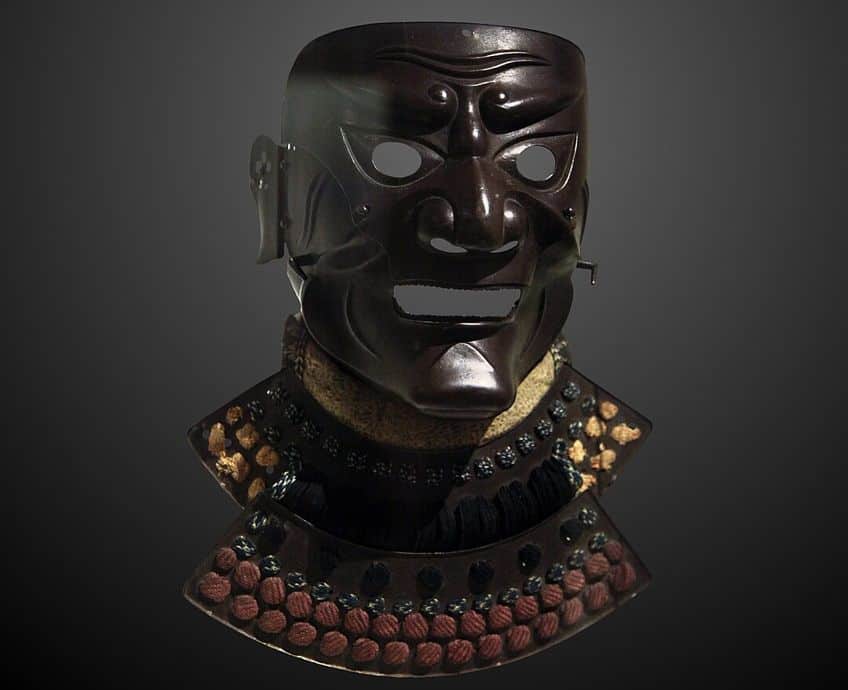
Rokushaku Masks
Rokushaku masks are an Edo-period traditional styled Japanese mask, which was crafted from papier mache and incorporated across street performances, folk dances, and kabuki theater shows. The versatile mask gained its name from the word “rokushaku”, which translates to “six shaku” and refers to the length of the mask. These masks were originally painted in bold colors and were considered ornate.
Rokushaku masks were used to depict male characters in Japanese plays and festivals such as figures from mythology and samurais.
Jō Masks
Playfully known as the “old man” masks, the Jō masks are an Edo-period Japanese mask that was created for comedy performances across Noh and Kabuki theater. The exaggerated features of the mask made it extremely amusing and featured prominent eyebrows, a beard, and a long nose, which was designed to stir the audience and bring child-like humor to the show. Jō masks are also known to hold significant cultural meaning since the old man aesthetic was intended to represent authority, wisdom, and convey moral messages during performances. The mask also signaled a prosperous life and was a symbol of longevity.
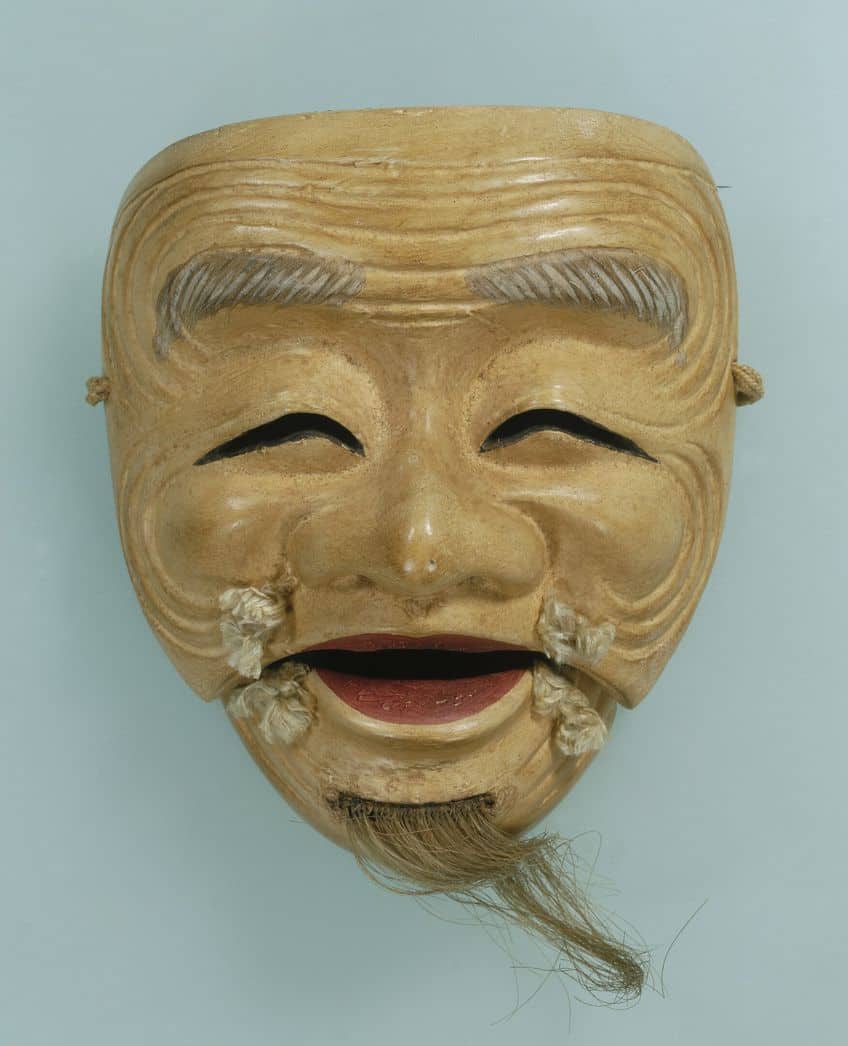
Menpo Masks
Menpo masks offer one insight into Medieval Japan, where these types of masks were donned by esteemed samurai warriors who took them straight to battle. Menpo masks were created specifically to safeguard the warrior’s face while demonstrating an expression of intimidation to the enemy. Menpo masks were created in a variety of forms fashioned from materials such as iron, leather, and even lacquer for durability and quality. Menpo masks were certainly the highlight of traditional Japanese masks since their meticulous craftsmanship and their notable function made them unique treasures for Contemporary fans. Menpo masks were designed with features such as a beard, a strong nose, and a mustache to amplify the commanding presence of the warrior and strike fear in the enemy.
Menpo masks continue to play a role in reenactments of past events and feature in Contemporary festivals as artifacts of the historical significance of the mask as a symbol of tradition.
Gigaku Masks
Gigaku masks were inspired by ancient Chinese origins and only debuted in Japan in the Nara period. Gigaku masks featured in religious ceremonies and were donned by dancers who performed in pairs, representing supernatural and human figures interacting with one another. Although Gigaku masks disappeared from Japanese usage after the Heian period, they soon saw a spike in popularity in the Edo period where they saw the handiwork of many talented craftsmen and painters. Today, Gigaku masks are one of the most highly sought-after Japanese masks by collectors of Japanese antiques.
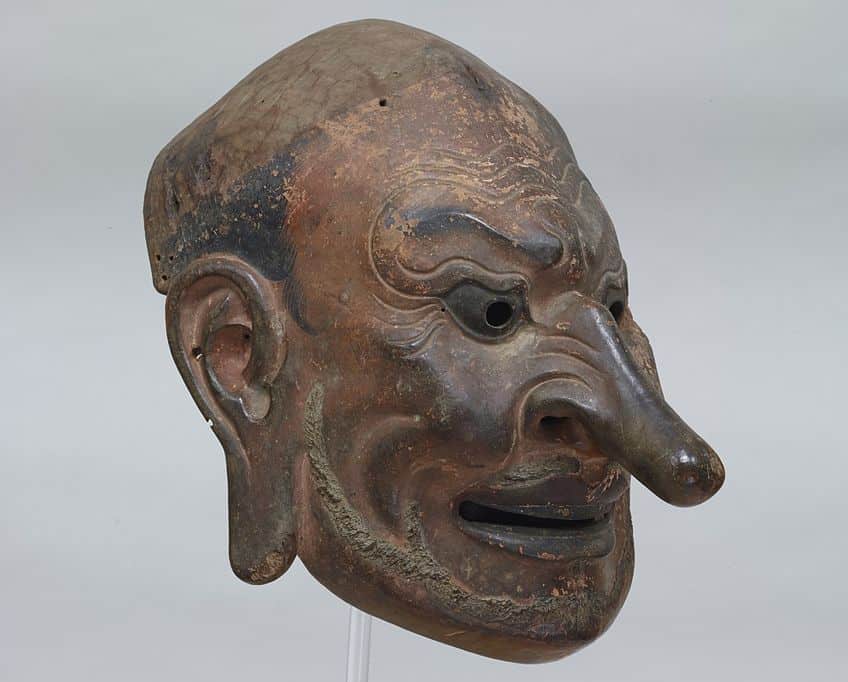
Kappa Masks
Kappa masks are considered to be one of the rarest types of masks and are based on Japanese mythology and refer to river monsters that challenge humans to sumo wrestling matches or attack them. Kappa masks are rarely seen in festivals and ceremonies and are instead often found on ancient statues. Japanese folklore also describes the creature as a water-dwelling animal with a humanoid form that is renowned for its malevolent and mischievous nature. Kappa masks were crafted with distinct features such as a beak-like nose with a green skin tone and a plate-like structure on its head for storing water.
The eyes of the Kappa masks are also widely set to give the figure an eerie appearance.
Kyogen Masks
Kyogen masks are among the most enchanting traditional Japanese masks that offer a sense of life and grace to classical Japanese comedy and theater. Kyogen masks make up the essence of Kyogen performance by evoking the vibrancy of its characters through intricate and nuanced features and a range of emotions crafted by skilled artisans. From solemn to whimsical and serious, Kyogen masks can portray almost any role while captivating the viewer’s attention through the rich amount of detail carved into the facial expressions of the mask. The origins of the Kyogen mask were found in Medieval Japan and had since remained an iconic part of Japanese theater for centuries.

The Making of the Mask
How are these wonderful objects made? Traditional Japanese masks were crafted from materials such as lacquer, wood, clay, and papier Mache, which were accessible and easy to use in long and complex emotional performances. The production of such masks required skilled hands and great attention to detail to achieve the desired emotion, concept, and shape of the mask specifications. When craftsmanship is concerned, one also needs to make note of the level of symbolism and cultural significance that masks carried, which made the artist’s job a lot more complex than a commissioned painting.
You would have noticed that the majority of traditional Japanese masks were commonly used in Noh and Kabuki theater and were created to represent a particular emotion or character inspired by Japanese folklore and mythology.
The making of masks was therefore not only a technical challenge to artisans but also required a conceptual and spiritual understanding of each mask, such that the actor could form a relationship with the mask and embody the character. Below, we will dive into the various traditional techniques and materials used in Japanese mask-making that will shed light on the evolution of traditional art-making practices of Japan into the technological age.
Materials and Techniques
General mask-making processes follow the creation of a mold while using a variety of techniques to refine the mask. These techniques involve processes such as carving and sculpting using materials such as wood and clay and adding smaller details with materials such as a lacquer or natural pigments for the final touches. Below, we will review some of the popular mask-making techniques found in traditional Japanese mask-making practices.
- Carving: Artists of ancient Japan used carving as one of the primary techniques to bring the characters of masks to life. The process of mask-carving spans centuries of Japanese history where artists employed material such as wood to carve intricate masks for a variety of functions ranging from rituals to theater performances. Each mask would be chiseled in alignment with the essence of the character and understanding of the emotion behind the mask. Sculptors would draw from their technical and artistic experience to deliver a mask that displayed the fine nuances of emotion while ensuring a great deal of precision in the detail of portraying characters such as Gods, historical figures, and spirits. Carved masks were also a medium through which the wearers could connect with the supernatural realm and were renowned for their “transformative qualities”.
- Lacquer: The use of lacquer in traditional Japanese masks was also a crucial element of mask-making and décor that was sourced from the sap of the lacquer tree. In the past, lacquer was a highly versatile and durable material that was used across Japan for many artistic practices. In Japanese mask-making, lacquer served several functions. This included the material being a protective coating to seal and preserve the aesthetic quality of the mask while protecting it from elemental damage and symbolizing social status. Lacquer was also a signal of the artist’s technical abilities since the process of applying lacquer required a reverent dedication to the mask and an acknowledgment of the importance of the art form. Applying lacquer was labor intensive and began with a base material such as wood, which was carved and then coated with multiple layers of lacquer. One had to allow each layer to harden before applying the next while ensuring the surface remained smooth. Artists would apply up to several layers of lacquer on a single mask and later embellish it with pigments, gold leaf, and other inlaid materials.
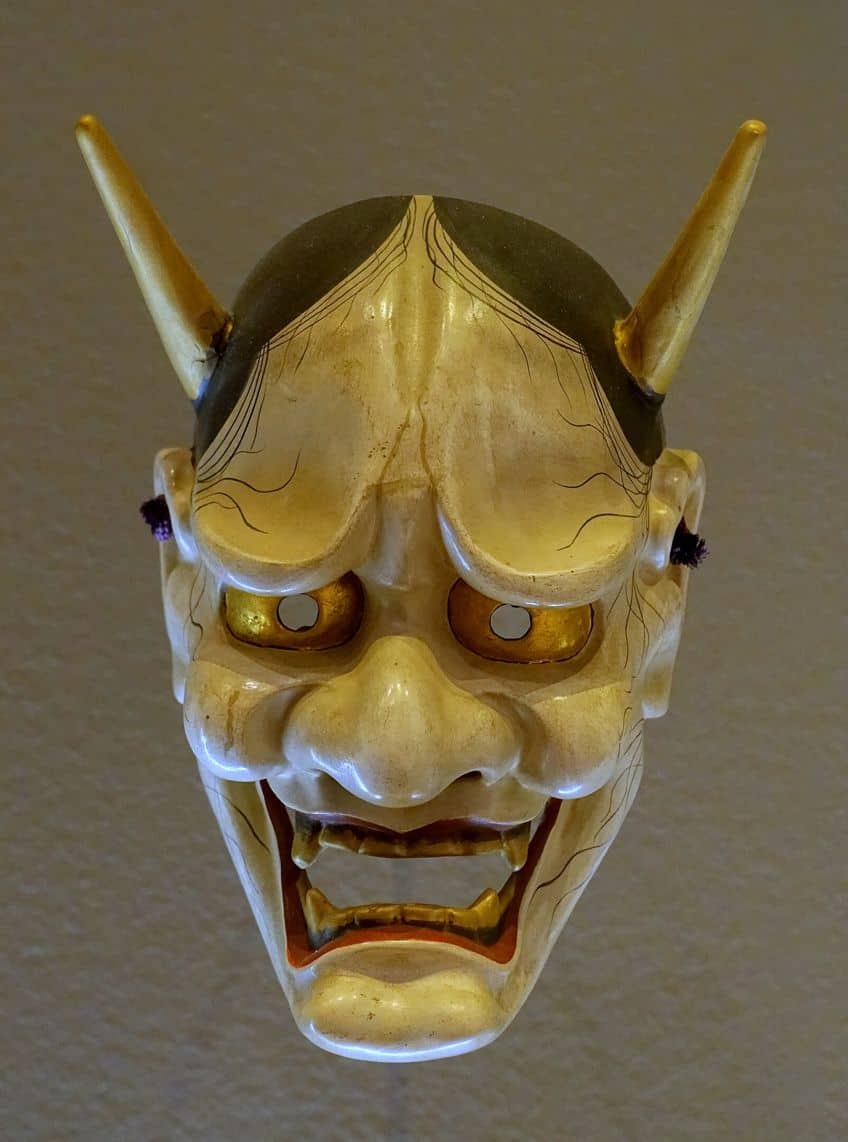
- Papier Mache masks: Paper mache masks were created using the traditional paper layering technique, which involves the layering of wet paper sheets or pieces onto a mold of a mask and allowing it to dry to produce a paper version of the mold. Once it has dried, the artist then decorates the mask with paint or coats it with lacquer or glue to ensure it is sturdy.
- Clay: Clay masks involve the use of a mold of the mask that is then baked in a kiln and decorated with paint and other materials. The process of clay modeling also involved significant preparation before the artist finalized the mask. The sculptor would gather the necessary materials and source the desired clay based on the method of firing used and the hardness and texture of the clay. An armature is also employed to support the base for the clay mask and provides stability to the process, such that the artist can mold the desired shape. Armatures were crafted from cloth, wire, and wood. While sculpting, the artist would also use knives, brushes, and spatulas to refine the mask’s facial features and add detailed expressions. After refining the rough edges of the mask, the artist would then allow the clay to dry and harden. Depending on the kind of clay the artist uses, the clay can either be air-dried or fired for extra durability. Kiln-produced clay masks undergo chemical changes in temperature change and can turn into hardened ceramics. Lastly, the artist colors the mask and applied glazes, lacquer, and paints to achieve the desired aesthetic.
- Textile masks: Traditional Japanese mask artists also incorporated textiles into their processes since textiles offer a variety of patterns and textural qualities to create unique masks. Textiles such as silk and cotton were used to enhance the mask’s design through fabric coverings that decorate the bases and were attached using adhesives and stitching methods. Embroidery and appliqué techniques were also common in ornate masks and were used to design intricate symbols. Other embellishments such as sequins, trims, tassels, and beads were also used to create striking and elegant effects while textile accessories were attached as headbands and headdresses to complement the mask.
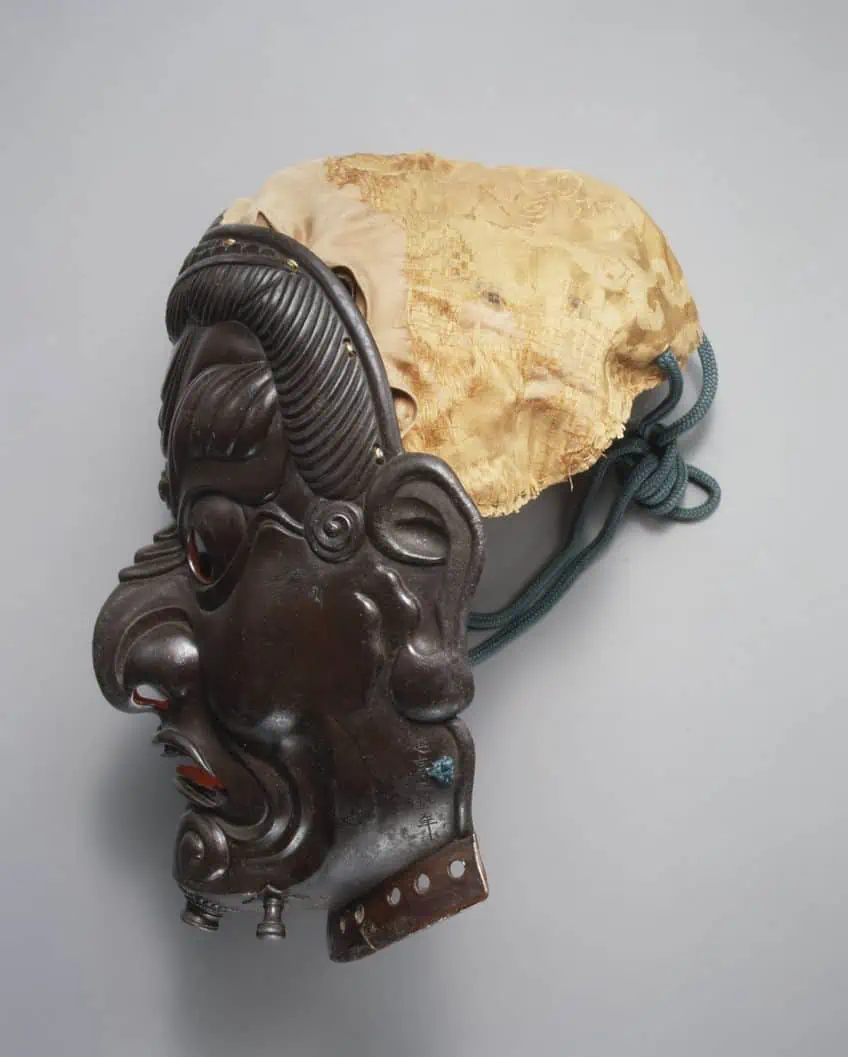
- Natural materials: Japanese artists employed a variety of natural materials to decorate masks and add a sense of texture and depth to the design. These materials included items such as shells, teeth, animal hair, and feathers.
- Pigments: Natural pigments made from minerals and plants were also sourced and used to produce vivid colors. A few examples of natural pigments that were incorporated into the process included red, yellow, and brown ochre extracted from natural rocks and iron oxide minerals, a plant-based dye called indigo, cinnabar, various mineral powders, and carbon black. Pigments such as indigo were used to symbolize protection and purity while the bright red pigment known as cinnabar was used in masks that represented deities or powerful characters.
- Gold leaf: Gold leaf was commonly used to add a sense of luxury to the mask and was applied using a special adhesive. Aside from its decorative function, gold leaf was meticulously applied to draw attention to specific areas on the mask to highlight expression while creating brilliant visual effects and motifs. The symbolism of the color gold in Japan was associated with wealth, divinity, and prosperity and was used by artisans to embed a layer of sacredness and status for the wearer or character. Expressions such as anger or laughter were also highlighted in gold leaf for an extra visual impact. Gold leaf was not only visually stunning but also prevented the deterioration of the mask by acting as a protective layer and barrier against the elements.
The process of mask-making also required an in-depth knowledge and understanding of symbols and cultural practices and in some cases, artists had to conduct their own research to accurately portray the expressions of the characters or creatures they sculpted. Artists would also follow up their research with preliminary sketches and drafts of the masks as well as outlining the materials they required.
After the mold was created via clay or papier mache, the mask maker would also carve the mask for a sense of refined detail and then paint and decorate the mask using natural pigments, gold leaf, and other textile elements to bring the character to life!
The Influence of Modern Technology on Technique and Production
In Japan, the art of traditional mask-making has seen periods of decline and popularity due to cultural changes and preferences as well as past government restrictions on performances. The ancient and medieval periods in Japan were primarily used in ritual and theatrical events that were also inspired by folklore and had never truly lost their original function. The Edo period, which lasted from the 17th to the 19th century, saw a significant rise in the popularity of traditional masks despite the restrictions on performing arts. During this period, Kyogen and Noh theater productions were highly favored and thrived among the samurai class.
The Meiji period of the mid-19th century saw a revival of the traditional arts and cultural practices while witnessing the modernization of society and a greater appreciation of the art of mask-making. Mask-making had thus become an act linked to national identity and cultural pride. The recent Contemporary decades seemed to maintain the appreciation of traditional arts in Japan, which was aided by many organizations and artists promoting their traditional art practices. Masks have become integral to various avenues of personal expression in society, including fashion, popular culture, and Contemporary art.

The influence of modern technology on the practice of mask-making in Japan can be noted by the increased accessibility that artists now have to new materials to improve traditional visual aesthetics and quality. The introduction of synthetic materials such as latex, plastic, silicon, and synthetic resins has allowed the production of a wide range of masks and more options for artists to experiment with and create masks that are durable and lightweight. Mask-making techniques have also improved since the introduction of advanced equipment and machinery such as 3D printers and CNC routers have allowed artists to create more complex works within a fairly short amount of time.
Modern technology has also enabled knowledge sharing between artisans and other interested buyers across the globe who can connect and expand the reach of traditional art forms such as mask-making.
Japanese Masks in the Contemporary Era
One might not be surprised to discover that the traditional practice of mask-making remains prevalent in Contemporary popular culture and theater performance. Theaters such as the Noh, Kabuki, and Bunraku divisions continue to use traditional masks as important elements of their performances to creatively narrate stories. Many Japanese festivals and ceremonies also incorporate masks in their routines to ward off evil spirits and invite good luck.

Festivals such as the Tsushima Tenno festival use masks to portray various mythical creatures and deities. In fashion and popular culture, designers adopt motifs and designs from Japanese masks for use in streetwear fashion and accessories. Elements of popular culture such as anime and manga have also incorporated traditional masks in their stories and among characters to widen their target audience. Today, Japanese masks stand as an important representation of Japanese culture and heritage and have been included in many exhibitions and gallery displays across Japan to represent the nation and show off the culture’s best craftsmanship.
The significance of traditional Japanese masks can be attributed to their longstanding history as an important tool in relaying messages about folklore and culture that younger generations can continue to learn from. The incredible attention paid to the production of traditional masks and the stories that inspire them also makes them unique artworks of Japan that captivate many. The next time you watch a Kabuki show, be sure to look out for any one of these vibrant and expressive masks of Japan!
Frequently Asked Questions
What Are Japanese Masks?
Japanese masks are important traditional sculptures that originated in the 14th century as accessories for rituals and theater performances. Japanese masks are crafted from different materials such as wood, leather, and cloth, and are highly symbolic artworks that can represent human characters, gods, and spirits. Traditional Japanese masks can represent a variety of human emotions and expressions, and be used in conjunction with folklore to relay stories about myths and the past.
What Are the Different Types of Japanese Masks?
There are many different types of Japanese masks to date. These include Noh masks, Kabuki masks, Hannya masks, Oni masks, Tengu masks, Hyottoko masks, Okame masks, Kitsune masks, Rokushaku masks, Shakkyo masks, Otafuku masks, Gigaku masks, Somen masks, Menpo masks, Kappa masks, Jō masks, and Tōkaidō masks, among many others.
What Were the Functions of Traditional Japanese Masks?
Traditional Japanese masks were crafted for different purposes. These include their most well-known function in the performing arts as an accessory for performance, as well as religious ceremonies, rituals, and as talismans for protection against evil or disease. In festivals, the masks are used to represent certain themes and characters. Masks are also used for decorative purposes as part of home décor, fashion accessories, or cosplay items.
Liam Davis is an experienced art historian with demonstrated experience in the industry. After graduating from the Academy of Art History with a bachelor’s degree, Liam worked for many years as a copywriter for various art magazines and online art galleries. He also worked as an art curator for an art gallery in Illinois before working now as editor-in-chief for artfilemagazine.com. Liam’s passion is, aside from sculptures from the Roman and Greek periods, cave paintings, and neolithic art.
Learn more about Liam Davis and about us.
Cite this Article
Liam, Davis, “Japanese Masks – The History of Traditional Japanese Masks.” artfilemagazine – Your Online Art Source. June 14, 2023. URL: https://artfilemagazine.com/japanese-masks/
Davis, L. (2023, 14 June). Japanese Masks – The History of Traditional Japanese Masks. artfilemagazine – Your Online Art Source. https://artfilemagazine.com/japanese-masks/
Davis, Liam. “Japanese Masks – The History of Traditional Japanese Masks.” artfilemagazine – Your Online Art Source, June 14, 2023. https://artfilemagazine.com/japanese-masks/.


